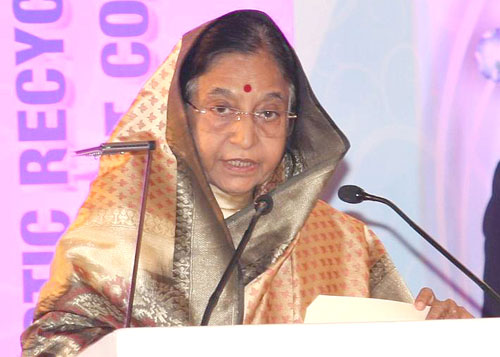Speech by Her Excellency the President of India, Shrimati Pratibha Devisingh Patil, at the Inauguration of the 7th International Plastics Exhibition and Conference - Plastindia 2009
New Delhi : 04.02.2009

Ladies and Gentlemen,
The 7th International Plastics Exhibition and Conference, which commences today, is an important event. I have been informed that about 20 countries have set up pavilions and that there are likely to be around 1,00,000 business visitors. This initiative provides a platform for stakeholders to meet and to enhance their business prospects through joint ventures and technology partnerships.
The need for better quality of life has been driving the human race, through the ages, to come up with new improved materials and create value added commodities. Over the years, there has also been a shift from conventional material based products, to chemicals based products, due to the need for conservation of natural resources, energy efficiency, innovative design and cost saving measures. Petrochemicals, along with its downstream products like plastics, have brought many benefits to human kind. Synthetic polymers, also known as plastics, have been one of the most versatile commodity materials invented in the twentieth century. Plastic with its inertness, lightweight and cost effectiveness, has proved to be a material that lends itself to multiple uses. This downstream petrochemical product permeates our daily lives in many aspects and caters to the needs of textiles and clothing, agriculture, packaging, infrastructure, healthcare, furniture, automobiles, information technology, power, electronics and tele-communications; and a host of other articles of daily and specialized usages.
The global demand for plastics since 1990 has grown at an average of 5.5 percent annually. I have been informed that global consumption reached about 200 million tons during 2008, with per capita consumption levels of 30 kilograms. North America and West Europe have high per capita consumption between 80 to 100 kilograms, while in China it is about 25 kilograms and in India around 5.5 kilograms. This sector is expected to grow at about 5 percent annually up to 2015, with the highest growth rates in Asia.
Rapid urbanization and growth in retail business in populous countries like India will result in high growth performance for the plastics sector. There are currently more than 50,000 units across the country with a turnover in excess of Rs. 80,000 crore. The Indian export performance has also been robust. The Indian plastic industry is relatively labour intensive and it is this feature of the industry, with a large number in the tiny, small and medium scale sectors, that has generated employment. During the coming few years, polymer consumption in India is likely to go up to 11 million tons from the current level of around 5.8 million tons, as we expand our infrastructure.
Government has announced a National Policy on Petrochemicals, the main objectives of which are to increase investments and competitiveness, both in the upstream and downstream sectors, to promote Research and Development and to create adequate skilled manpower, with an overall objective to achieve environmentally sustainable growth in the petrochemical sector. I am told that Indian industry is gearing up to meet these challenges. I am sure that with a vast talented and skilled manpower; and well-established and globally reputed institutions; we will take major strides in Research and Development activities in areas of material development, like high performance plastics and biodegradable polymers. We need to lay emphasis on development of value added, quality petrochemical products at globally competitive prices, using eco-friendly processes and technologies.
Due emphasis needs to be placed on the impact of plastics on the environment. Plastics are chemically inert by nature, but it is the question of degradability, which has attracted severe criticisms on its applications all around. Their non-degradability, makes them one of the negatively targeted materials in the eyes of environmentalists. Even though it is estimated that more than 30 percent to 40 percent of plastic waste generated, is re-cycled into useful products, yet we must continue to lay emphasis on waste management. Plastic articles strewn all across the country - in its hills and rivers and in streets - have caused general public ire and environmental harm. It is this indiscriminate littering, which is the basic reason for concerns regarding the waste generated. We need to adopt a responsible approach in the use of plastics. Effective waste management of plastics, by adopting proper recycling technology, is the need of the hour to deal with the menace of plastics waste. To a large extent, the lack of appropriate mechanism for segregation and disposal of plastic waste is one of the main problems. Plastics waste is not waste per se, and can be treated as "Wealth", by recycling them into value added products. There is thus a need for concerted efforts by industry and civil society for bringing awareness about the proper use and disposal of plastic waste and for developing suitable mechanisms for systematic waste collection and recycling.
I understand that modern technologies exist which could address this issue. I would appeal to all present today, to take inputs from this exhibition for adopting suitable technologies for effective waste management and cleaning up the environment. The Recycling Parks concept could be developed by the participation of the Central and state government agencies, the industry, local self-government and civic bodies.
I would like to convey my good wishes to the Plastindia Foundation for their work in promoting the development of the Indian industry. I would compliment them for their efforts in organizing exhibitions, including this Exhibition to showcase Indian Industry as "The Emerging Global Sourcing Hub of Plastics".
I wish Plastindia 2009 a great success.
Thank You,
Jai Hind.








